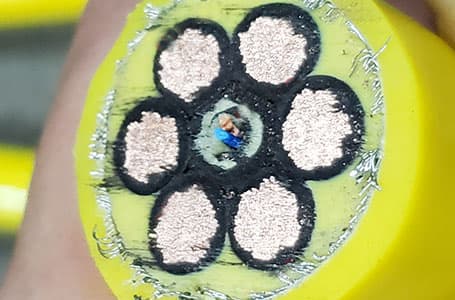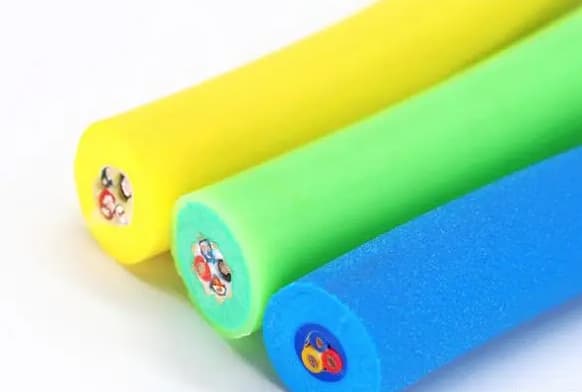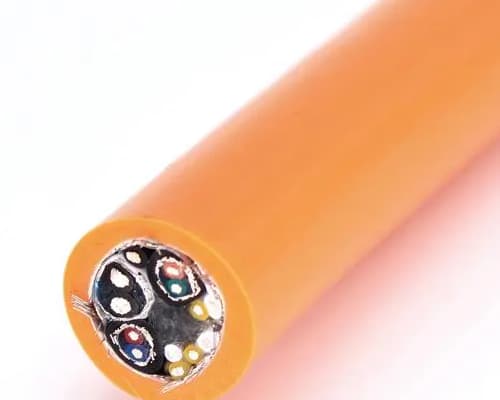Umbilical cable , a combined cable system that is vital in specific fields, especially in marine engineering and aerospace technology. it named rov umbilical cable, subsea umbilical cable, umbilical cord cable, umbilical electrical cable. this article summarizes its key features, aplicatii, structure, technical challenges and future trends so that you can have a comprehensive and in-depth understanding of this topic.

eu. Overview of umbilical cable
Umbilical cables, as the name suggests, are inspired by a baby’s umbilical cord, which connects the mother to the fetus and provides the fetus with the nutrients and oxygen it needs for life. In the field of engineering and technology, umbilical cables play a similar role by connecting equipment underwater or in special environments with external systems, providing these equipment with power, signaling, and possibly fluid (de exemplu., hydraulic power, chimicale, etc.) transport functions.
2.the field of application umbilical cable
1)Marine engineering
In offshore engineering, umbilical cable is a key component connecting underwater equipment such as floating production systems (e.g. FPSO), submersibles, ROVs (underwater robots), etc. with the upper platform or vessel. It can not only provide stable power supply for these underwater equipments, but also realize high-speed data communication and necessary fluid transmission, which is an indispensable infrastructure for activities such as marine oil and gas exploration, development, production, and marine scientific research.
2)Aerospace technology
In the field of spaceflight, umbilical cable also plays an important role. It may be used to connect a spacecraft to a ground station or other spacecraft to ensure power supply, signaling, and possibly fluid (de exemplu., fuel, coolant, etc.) management during mission execution. Although umbilical cables in aerospace differ from those in ocean engineering in terms of design and application, their roles in ensuring smooth mission execution are the same.
3)the structure of the composition
The structure of umbilical cables is complex and varied, depending on their application environment and required functions. Generally speaking, it contains the following main parts:
Cable unit
The cable unit is the part of the umbilical cable used to transmit power. It is usually made of highly conductive metal wires (de exemplu., copper, aluminum, etc.) and wrapped with insulation and sheathing layers to protect the internal metal wires from the external environment.
Optical fiber unit
Fiber optic cable unit is used to transmit optical signals to achieve high-speed, high-capacity data communications. It usually consists of optical fibers, reinforcing elements and sheaths, of which optical fibers, as a transmission medium, have the advantages of high bandwidth and low loss.
Fluid piping
In some applications, umbilical cables also need to contain fluid ducts to transmit fluids such as hydraulic power and chemicals. These pipes are usually made of corrosion-resistant, high-strength materials to ensure stable operation in harsh environments.
Sheathing and reinforcement
In order to protect the internal cables, fiber optic cables and fluid ducts from the external environment, umbilical cables are usually wrapped with sheathing and reinforcement layers on the outside. The sheath is usually made of polymer materials with excellent corrosion and abrasion resistance, while the reinforcement layer is usually made of high-strength materials such as steel wire or Kevlar to enhance the tensile and compression resistance of the umbilical cable.

3. Application of umbilical cables in the ocean
Application of umbilical cables in the ocean is extremely wide, mainly involved in the development of marine resources, marine scientific research, deep-sea exploration and underwater equipment connection and many other aspects. The following is a specific description of the application of umbilical cables in the ocean:
1) the development of marine resources
Marine oil and gas exploration and development:
Umbilical cables connect floating production systems (de exemplu., FPSOs) to subsea oil and gas production facilities, providing these facilities with a stable power supply and data communications.
Transmitting hydraulic power and chemicals, they support the various operations in the subsea oil and gas production process.
On deep-sea drilling rigs, umbilical cables carry the rig’s load and energy supply, ensuring smooth drilling operations.
Seabed Mining:
In seabed mining operations, umbilical cables are used to connect the mining equipment to the offshore platform, providing the necessary power, communication and control signals.
Transmission of fluids required for mining (de exemplu., cooling water, chimicale, etc.) supports the continuity of mining operations.
2)marine scientific research and deep sea exploration
Deep-sea scientific research:
Umbilical cables connect deep-sea research vessels to underwater robots (de exemplu., ROVs, AUVs, etc.), providing power and data communication support for these robots.
Real-time data transmission is supported, enabling scientists to have real-time data and images of the deep-sea environment, improving the efficiency and accuracy of scientific research.
Deep Sea Exploration:
In deep-sea exploration missions, umbilical cables not only provide power and communication support, but may also include the function of transmitting fluids (such as seawater samples in sampling tubes).
It is suitable for a variety of exploration tasks such as deep-sea drilling, biological exploration, etc., and meets the requirements of different exploration needs on the performance and structure of the cable.
3)underwater equipment connection
Underwater observatory and sensor:
The umbilical cable connects the underwater observatory and sensors with the land or sea control center, realizing real-time data transmission and remote monitoring of equipment.
It supports long-term observation tasks and provides continuous and reliable data support for marine scientific research.
Underwater production system:
In the underwater oil and gas production system, the umbilical cable connects each production equipment (such as valves, pumps, etc.), providing power, communication and control signal support.
It realizes automation and intelligent control of the production process and improves production efficiency and safety.
4) the technical characteristics and advantages
Multifunctionality:
Umbilical cable integrates power, communication and fluid transmission functions, which can meet the complex and diverse needs of marine applications.
High reliability:
The use of high-strength, corrosion-resistant materials and advanced manufacturing processes ensures stable operation in harsh marine environments.
Customized design:
Customized design according to different application scenarios and needs, including cable specifications, materials, length, structure and included functions.
Intelligent development:
With the development of technology, the umbilical cable will pay more attention to the intelligent development, integrated sensors, controllers and other intelligent components to achieve real-time monitoring and intelligent control of the cable status.
5) Application Examples
In deep-sea oil and gas development, umbilical cables connect FPSO and underwater production facilities, providing stable power and communication support for production.
In deep-sea scientific research, ROV and other underwater robots are connected to the research vessel through umbilical cables to realize real-time data transmission and remote control.
In the submarine observatory project, the umbilical cable connects the observatory with the land control center to realize long-term and continuous observation of the marine environment.

4 Umbilical Cable Future development trend
1)Intellectualization
The future of the umbilical cable will pay more attention to the intelligent development. Through the integration of sensors, controllers and other intelligent components, to achieve real-time monitoring and intelligent control of the cable state, to improve the safety and reliability of the system level.
2)Environmental protection
With the increasing awareness of environmental protection and the increasingly strict environmental regulations, the future of the umbilical cable will pay more attention to the development of environmental protection. The use of environmentally friendly materials, optimize the production process and other measures to reduce energy consumption and pollution emissions in the production process; at the same time, strengthen the recycling of waste cables and the use of work to reduce the impact on the environment.
3)High-performance
In order to meet the more complex and demanding applications (such as deep-sea exploration, polar research, etc.), the future of the umbilical cable will pay more attention to the development of high performance. Through the use of new materials, new technologies and other means to improve the cable’s corrosion resistance, compression resistance, flexibility and other performance indicators;
4)Long life
Given the high cost and high risk applications of umbilical cables in harsh environments such as marine and aerospace, improving the service life of the cables has become an important research direction. Future umbilical cables will use more durable materials and more advanced anti-corrosion technology to extend the service life of the cable and reduce the frequency of replacement and maintenance.
5 Umbilical Cable Environmental Impact and Sustainable Development
In the development and application of umbilical cables, it is important to fully consider their environmental impact and promote sustainable development. This includes the use of environmentally friendly materials, reducing energy consumption and pollution emissions in the production process, and enhancing the recycling and utilization of waste cables. At the same time, it is also necessary to pay attention to the impact of cables on marine ecosystems and biodiversity in the process of use, and take corresponding protective measures.
6 Umbilical Cable Conclusion and Prospect
As an important part of marine engineering and aerospace science and technology, the development and application of umbilical cable are of great significance in promoting scientific and technological progress and economic development in related fields. In the future, with the continuous progress and innovation of technology, umbilical cables will make greater breakthroughs in intelligence, environmental protection, high performance, integration and lightweight. At the same time, we also need to pay attention to its environmental impact and sustainable development issues, in order to achieve a harmonious symbiosis between science and technology and the environment. Looking to the future, umbilical cables will continue to play an important role in the development of marine resources, deep-sea exploration, aerospace exploration and other fields, contributing to mankind’s exploration of the unknown world and promoting social progress.
7 Umbilical cable manufacture and supplier
Dosense Cable are the leading umbilical cable manufacturer and supplier, umbilical cables tailored for the most demanding marine and offshore applications. Our expertise lies in crafting high-performance, multi-functional cables that seamlessly integrate power, communication, and fluid transmission capabilities.
With a focus on innovation and reliability, Dosense Cable offers customized solutions to meet the unique challenges of deep-sea exploration, oil & gas production, and scientific research. Our cables are engineered to withstand extreme pressures, corrosive environments, and long-term deployment, ensuring uninterrupted service and maximum operational efficiency.
Trust Dosense Cable for your umbilical cable needs. Experience the difference of working with a partner committed to excellence in design, manufacturing, and customer support. Contact us today to learn more about how we can empower your next marine project, we provide umbilical cable price and technical support.
